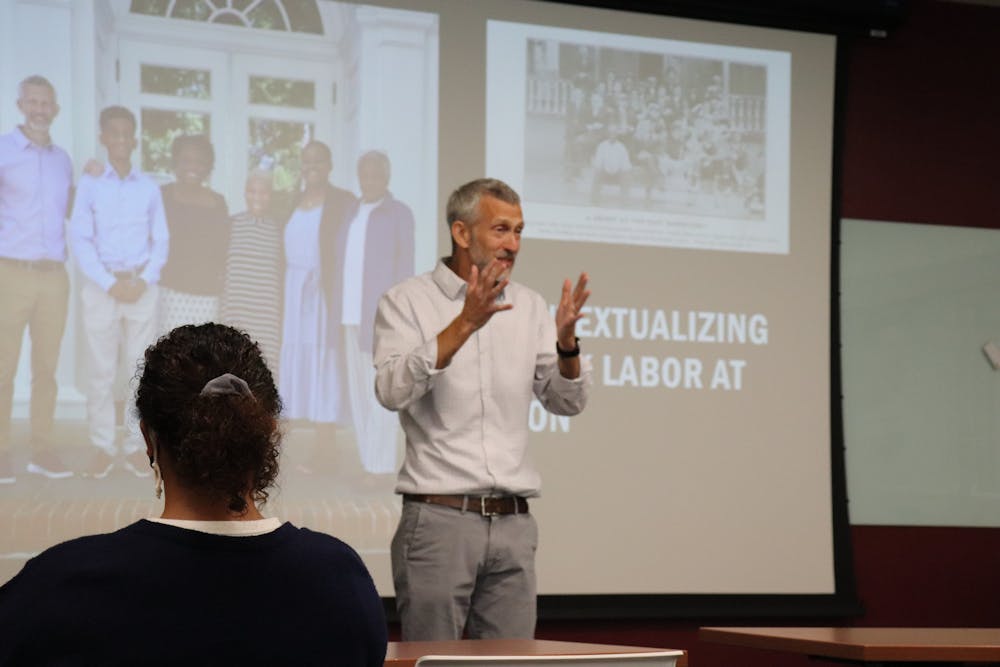Elon University, originally founded in 1889 as an all-white institution, launched what is now known as the Committee on Elon History and Memory in 2018. This committee has been working to educate members of the Elon community about some of the institution's complex history around race.
Charles Irons, the committee chair from 2018-21 and professor of history, said the goal of the committee when it was created was “to explore questions related to historical memory and collective identity at Elon University.” The committee submitted a report focused specifically on Black identities in fall 2020. Evan Gatti, the current chair of the committee, is on sabbatical.
“Elon started as a white-only institution, but no one had wondered about the implications of that or the extent to which Elon’s leaders participated in the white supremacy that characterized the age,” Irons said. “This work just hadn't really been done.”
One example of the committee’s work has been their effort to understand the experiences of one of the first Black staff members, Pinkney Comer.
According to the report, Comer was not treated with dignity by groups on campus while working to maintain Elon’s athletic fields during the 1910s, and he died in unknown circumstances on the train tracks.
“White students in Elon’s Clio Literary Society made Comer the butt of a very public and ugly joke in early 1920,” the Committee on Elon History and Memory wrote. “They scripted an elaborate ‘Black-face playlet in three acts,’ which they performed to the delight of their audience. According to the Greensboro Daily News, ‘The second act consisted of a mock trial with a local setting, in which the case of Pickney Comer who was charged with beating his wife was tried.’”
Irons said this is an example of Elon’s complicated history. The university honored Comer by dedicating an athletic field to him, yet his experience at Elon was not one that should only be celebrated.
“Pickney Comer, on the one hand, is the first Black person for whom a university facility was named,” Irons said. “But it is also undeniable that Comer labored under a segregated system and was treated poorly by at least some white students. So, two things are true at the same time: even the honor of naming the field, ‘Comer Field,’ was compromised by the difficulties of Comer’s lived experience.”
Simone Royal, one of the assistant directors of the Center for Race Ethnicity and Diversity Education and Elon ‘17 alumna, said while in her role in the CREDE she doesn’t work directly with the history and memory committee, both campus organizations work to support each other.
“The history and memory committee are working toward what are some actionable steps and changes that they can put in place on campus to continue to educate not only our current students, but prospective families students,” Royal said.
Royal said even though she was a student here, much of Elon’s history was not something she was familiar with.
“As a Black student, there's information, things that I knew about that was public,” Royal said. “For instance, when our first Black students attended Elon, when our first Black student graduated. Those are very open and public information that Elon shares both downstairs in Moseley. We have different awards to celebrate those folks, but outside of that there's a lot of ins and outs in details that I did not know.”
Irons said this was the starting place of the committee and from there it has been working on next steps of restorative justice.
“What do you do if you find out that your university is implicated in a certain way?” Irons said. “How do you respond to the discovery of historic injustice? These questions about what to do with the information we’ve been learning have been somewhat divisive.”
In 2020, the university dedicated the Janice Ratliff building, the first building named after a Black person. Irons said while this is something the committee was happy to see, there hasn’t yet been a system put in place to make the process for naming buildings more inclusive. Irons said this is something that some universities have started doing, such as Duke University, but a commitment to inclusive naming practices is not yet commonplace.
Another step that the committee has discussed is adding physical markings on admissions tours so Elon’s Black history is better highlighted and other small changes that can be made.
“That would be a concrete change,” Irons said. “There are also other things that seem to me to be low-hanging fruit, like changing the timeline of images outside of Belk Library that tells the campus story. It’s perhaps the whitest campus history you could possibly see, so we could rewrite that to include diverse storylines.”
Royal said that while she isn’t sure how many students are aware of the work of the committee, she said Elon has been working to engage students and she has seen through the work of the CREDE that students are more open to learning about Elon’s history.
“I've already always been aware of certain things,” Royal said. “But I think it has just brought, for me personally, more awareness to it and it has allowed me to really examine what my purpose is, both in life but more specifically, in this role at this campus supporting these students. … How do we translate that to students in a meaningful and engaging, impactful way that they can really take from this and go out into the world?”


